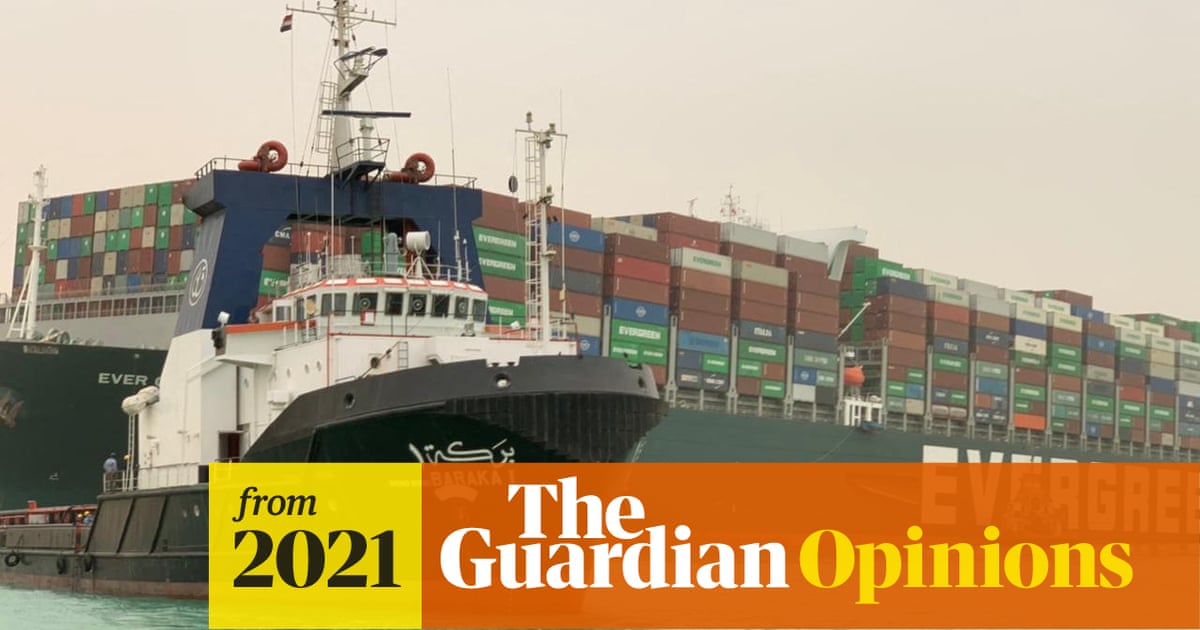Ah, I didn't know he was a Maritimer.
Was the captain drinking heavily, and just ran aground?
Was the captain drinking heavily, and just ran aground?
First move all the ones it can lift off first. Very likely a majority of them are under 44k lbs...seen if that helped enough to refloat the boat. If not, have a helicopter lift a piece of equipment onto the deck in a few pieces, reassemble, and of the containers left, drag out the contents, or most likely partial contents, onto the deck. Sure a few things might be one piece, that are too heavy, but a crew with cutting torches would be able to tackle a lot of them. It would take days, but at least it would be doing something. Hopefully the captain is charged and loses his license, that is BS to get his/her boat sideways and stuck.

Opportunists the world over are posturing so they can say, "Oh, this price increase is due to the Suez blockage".
Q: Are container trucks being routed to the region to clear the backlog?
I don't remember high wind advisory on bridges tell me to go faster in the wind. I dunno.
I don't remember high wind advisory on bridges tell me to go faster in the wind. I dunno.
Going over land is a long and difficult journey. In the Middle Ages everyone would over-estimate the distance, leading makers of maps and globes to place Japan much closer to the west coast of Europe than it actually is. Yes in that time scholars understood that the Earth was round, and knew very closely how large it was-- but what was not known was the actual distance from Europe to Asia.Where would those trucks go? From Egypt to? Across the Sinai to?
I tried to explain that.How did it get stuck, and sideways at that?
I agree.Unless there is a true error committed, I think this needs to be chalked up to the learning curve of dealing with ships of this size. I suspect neither the channel captains, nor the ship's captain have a great deal of experience going through the Suez with something so massive. This incident is part of the establishment of procedures when it comes to this class of container ships. Maybe the canal needs some updates. Maybe certain weather conditions preclude passage. Some root cause analysis and preventative updates will certainly follow.
Sorry, I didn't read your original reply.I tried to explain that.
The ship displaces water.
That water displacement causes high pressure on the bow, and low pressure (suction) between ship and bank. It’s called bank effect.
The wider the ship in relation to the canal, the greater this effect. The low pressure is the result of water that the ship displaced, flowing past the ship to fill in behind it. The faster this flow, the lower the pressure, so, of the ship is closer on one side than the other, there is a pressure differential. Closer it gets, the worse the effect.
This very big ship was going through the canal during severe weather. Wind pushes the ship to the side. The ship steers “into” the wind to keep from hitting the bank. It’s sailing at an angle. To have enough rudder control to counter that wind pressure, they had to go faster. More water over the rudder increases its effectiveness.
But faster increases bank effect.
The best guess is that when it got close to the bank, bank effect pulled the stern towards the bank, and the high pressure on the bow pushed towards the opposite bank.
A ship of this size takes miles to stop. Miles. It’s hundreds of millions of pounds of mass, so if it became unstable in a narrow canal, there isn’t anything they could do. Cargo alone on this ship was about 200,000 tons. So, 400 million pounds of cargo, give or take.
Ship handling isn’t anything like driving. Ships move through a fluid. That fluid moving in the canal creates forces that you wouldn’t expect, unless you were a ship driver. The bigger the ship (and this one is big), the greater the effect. The bigger the ship in relation to the canal, the greater the effect.
Throw in heavy weather, and it becomes a huge challenge.
There were a couple articles that seem to claim that the pilots don't really do anything and it's the captains that steer the ship. Like they're part of the fee that gets charged for moving through the canal.I agree.
Particularly about the pilots, like many harbors, the Suez likely requires one of their pilots on board for navigation. So, I think it’s really a matter of training Egypt’s own pilots who are, ostensibly, already expert at navigating this stretch of water.
And in 2105, Egypt began widening the canal.
Fascinating. Very different than the pilots that I've seen in other harbors...There were a couple articles that seem to claim that the pilots don't really do anything and it's the captains that steer the ship. Like they're part of the fee that gets charged for moving through the canal.
There's a few accounts from some captains that say they don't do anything.Fascinating. Very different than the pilots that I've seen in other harbors...
That certainly doesn't help the risk management...

So have I. I certainly don't miss sitting on the Radar during reduced visibility, high traffic, low maneuverability operations. I still wake up from dreams where I am sitting on the Radar. If the winds were as bad as they say, and the ship was going slow, it is like driving a big sail. I was know we pick up pilots on the submarine as well. I was always told that the CO maintains responsibility even if there is an incident with the Pilot on board.No worries. Don’t claim to know precisely what happened.
Seen enough ship driving to know it ain’t easy n
